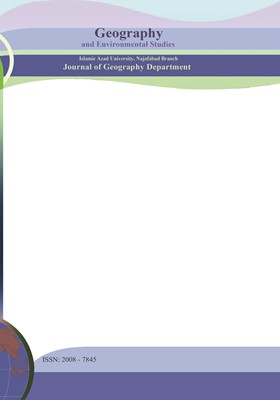Temporal-Spatial Analysis of Numbering Trend of Thunderstorm Days in Iran
Subject Areas :Mohammad Darand 1 , Mahtab Narimani 2 , Jila Shariati 3 , Shermin Namdari 4
1 - استادیار اقلیم شناسی دانشکده منابع طبیعی دانشگاه کردستان
2 - دانشجوی کارشناسی اقلیمشناسی دانشکده منابع طبیعی دانشگاه کردستان
3 - دانشجوی کارشناسی اقلیمشناسی دانشکده منابع طبیعی دانشگاه کردستان
4 - دانشجوی کارشناسی اقلیمشناسی دانشکده منابع طبیعی دانشگاه کردستان
Keywords:
Abstract :
Monthly data of numbering trend of thunderstorm days connected to 50 synoptic stations of Iran during 1/1980 to 12/2010 were used to do this research. One matrix with dimensions 372×50 was created where there was time (months) on the rows and columns were located with place or analyzing synoptic stations. Nonparametric Mann Kendal test was used to analyze variance of numbering trend of thunderstorm days. The significance of trend at confidence level was 95% of test. The Sen Estimator was applied to estimate variance rate. The results of this study showed that the frequency of thunderstorms days of Iran experienced a significant variance during analyzing period. The frequency of thunderstorms increased on synoptic stations during most of the months of the year. The increasing trend of most stations located in northwest, west, north and northeast was significant at 95% confidence level. The extent and increasing rate of frequency of thunderstorm days in spring was more than other seasons. In contrast to other months most of western stations experienced significant decreasing trend in March. It seems that the reason of these variances in frequency of occurrence of this atmospheric phenomenon resulted from variance of reaction of synoptic systems of effective scale on climate of Iran. The increasing reaction of Siberian anticyclone results in other conditions over northern parts of country during spring and summer and it results in increase of thunderstorms occurrence over northern parts of country. Also decreasing trend in March is resulted by decreasing trend in Sudan and Mediterranean cyclonic systems activity.
17- Yang X and Z Li. (2014): Increases in thunderstorm activity and relationships with air pollution in southeast China. Journal of Geophysical Research – Atmospheres, 119(4), doi:10.1002/2013JD021224.
_||_

